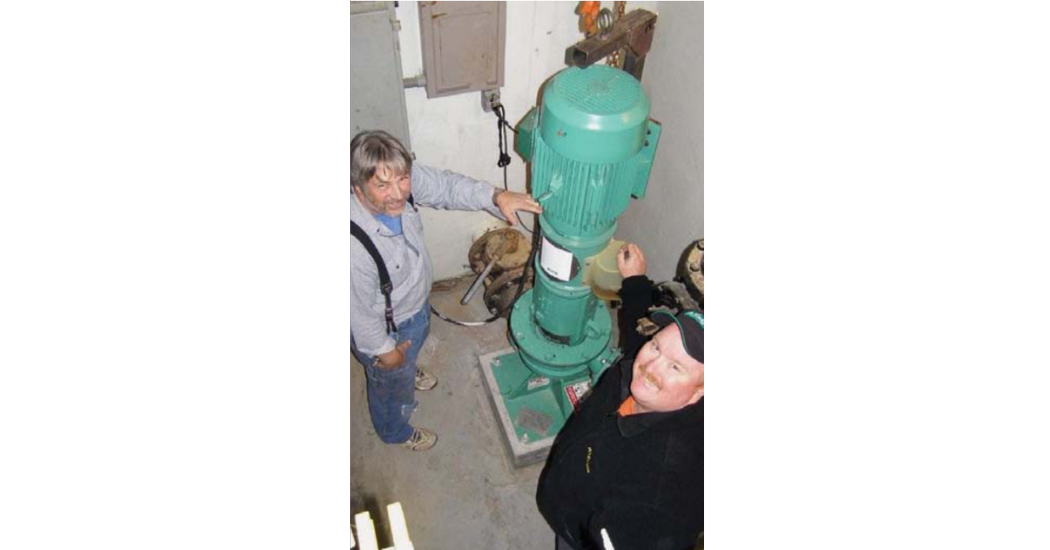Centrifugal chopper pumps in a major lift station put an end to frequent plugging that drove up costs and threatened SSOs
The Jefferson Street Pump Station in Centralia, Wash., handles one-third of the city’s sewage from six other pump stations and a 24-inch interceptor line. The average flow is 350,000 gpd. In 2002, lead wastewater collection technician Greg Boone began noticing disposable wipe products in the waste stream. “When Jefferson backs up, it’s a large area, so we take immediate action even if one pump clogs,” he says.
Routine weekly maintenance involved two technicians entering the dry well and visually inspecting the twin 10-year-old submersible pumps. At first, the men had one plug per week. Then it became twice a week — often after hours. It took them two hours to pull and clear the pump. By 2007, the crew amassed more than 40 overtime instances besides the clogs that occurred during work hours.
“I remember saying grace at Thanksgiving one year when the phone rang,” says Boone. “Plugging had become a nightmare, creating a lot of extra maintenance and overtime expense.”
Working with PumpTech Inc., a pump distributor in Rochester, Wash., Boone found a cost-effective, reliable solution with a centrifugal chopper pump. The successful installation protects the environment by keeping sewage in the pipes until it reaches the wastewater treatment plant.
Ragging problems
Boone, who was the city’s pump technician at the time, first considered changing out the impellers on the dry-pit submersible pumps. “The pumps worked great, but they just couldn’t handle the disposable wipes,” he says. “However, nobody I called could guarantee that their vortex impellers would end the ragging problem, and often the efficiency was wrong. The variables to these pumps drove me wild.”
Then Boone recalled a demonstration he had seen seven years ago when Vaughan Company Inc. visited the station with a trailer-mounted chopper pump. The representative threw in ropes and towels, but they didn’t plug the pump. “Ragging wasn’t a big problem at the time, and we didn’t switch over because the chopper pumps were more expensive,” says Boone. “But now, given all the over-time the city was paying, the pumps seemed cost effective.”
Boone called Mike Hoskison at PumpTech, who offered to take him, his three technicians, and department manager to the Vaughan factory for a chopper pump demonstration. “They had one horizontal dry well pump in a tank and dumped in nylon ropes, T-shirts, rags, a box of wipes, small chunks of wood — even a frozen turkey,” says Boone. “I kept expecting the pump to plug, but it didn’t. That put a whole new light on what I needed to correct the problem.”
Unlike grinders
The city ordered two Vaughan model PE4P6CS-088 vertical pedestal chopper pumps with 15-hp/1,760- rpm motors. They are specified for 640 gpm at 41 feet of total dynamic head (TDH).
The term “chopper pump” is often used generically to describe any type or brand of chopper pump, cutter pump, grinder, or comminutor. However, the Vaughan centrifugal chopper pumps have a cartridge-style mechanical seal that reduces problems associated with wrapping or abrasion. Stray solids trapped in the mechanical seal area are shredded and removed by the impeller vanes turning against the upper cutter.
The sharpened impeller blades turning across the cutter bar chop solids in a smooth, slicing effect. A
cutter nut at the pump inlet cuts stringy materials that wrap around the shaft. The conditioned slurry passes through the pump and conveyance system without plugging.
The city hired PumpTech to change out the pumps at the Jefferson Street station. The new ones, which use a flushless cartridge mechanical seal to simplify installation, were up and running in two days. “The increase in horsepower requires a little more electricity, but paying slightly higher electrical bills is preferable to SSOs,” says Boone. Centralia has 75 miles of sewer line and more than 1,000 manholes.
More replacements
Boone, who maintains the city’s 25 lift stations, replaced the two aging pumps at the larger Borst Park Pump Station in November 2009. PumpTech installed Vaughan model PE6W8CS-094 vertical dry chopper pumps with 30-hp/1,750-rpm motors. They are specified for 1,100 gpm at 58 feet of TDH.
Previously, Boone’s crew installed a Vaughan model SE4L-075 submersible chopper pump on a rail system with 10-hp/1,755-rpm motor at the Reynolds Pump Station. This pump is specified for 370 gpm at 46 feet of TDH. None of the pumps have clogged despite an increase in wipes.
“I remember saying grace at Thanksgiving one year when the phone rang. Plugging had become a nightmare, creating a lot of extra maintenance and overtime expense.”- Greg Boone
Shown with the chopper pump from Vaughan Company are Greg Fischer, wastewater electrician for the Chehalis Public Works Department (left), and Greg Boone, lead wastewater collection technician.
Originally published in Municipal Sewer & Water.




